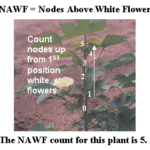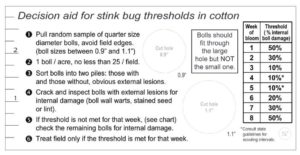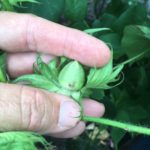Counting  Nodes Above White Flower (NAWF) is a good way to monitor a cotton field’s maturity after bloom. The process is done by finding the first position white flower and counting the number of nodes (branches) above the branch with the white flower. The last node to count is the highest node with an unfurled main stem leaf (at least 1-inch wide).
Nodes Above White Flower (NAWF) is a good way to monitor a cotton field’s maturity after bloom. The process is done by finding the first position white flower and counting the number of nodes (branches) above the branch with the white flower. The last node to count is the highest node with an unfurled main stem leaf (at least 1-inch wide).
NAWF is useful for management of your cotton crop.  By tracking NAWF, you can see how the crop is maturing compared to an expected growth curve. This has been explained in the document “Interpretation of Crop Growth Patterns Generated by COTMAN.” LINK
By tracking NAWF, you can see how the crop is maturing compared to an expected growth curve. This has been explained in the document “Interpretation of Crop Growth Patterns Generated by COTMAN.” LINK
End of season insect management decisions can also be made using NAWF. When a cotton field reaches 5 NAWF, we consider the field at cutout. This means the plants are no longer continuing to add fruit and are focusing more on maturing the fruit already on the plant.
From cutout we can begin to measure heat unit accumulation to determine when the field will be “safe” from stink bug and bollworm attack.
Heat units (HUs) are measured by averaging the daily high and low temperatures, then subtracting 60. For example, a day with a high of 90 and a low of 70 will have 20 heat units. (90+70) / 2 – 60 = 20
Fields that have accumulated 350 HUs beyond 5 NAWF are no longer susceptible to first or second instar bollworm/tobacco budworm larvae. LINK
Once the cotton has reached 450 DD60 (degree days 60) beyond cutout (five nodes above the white flower), sampling and treating for stink bugs may no longer be necessary since bolls produced after this point will not become fully mature or contribute significantly to the crop yield. LINK
Average  August temperatures results in around 22-23 HUs per day. Thus, 350 HUs will require 15-16 days and 450 HUs will require 20-21 days.
August temperatures results in around 22-23 HUs per day. Thus, 350 HUs will require 15-16 days and 450 HUs will require 20-21 days.
